Xylophanes anubus anubus
|
|
Updated as per
AN ANNOTATED CHECKLIST OF THE SPHINGIDAE OF BOLIVIA, October 2007
Updated as per http://www.pybio.org/SPHINGINAE.htm (Paraguay), October 2007
Updated as per More, Kitching and Cocucci's Hawkmoths of Argentina 2005, October, 2007
Updated as per Catalogo de las Especies de Sphingidae en Honduras, Ana Clariza Samayoa and Ronald D. Cave;
December 2009
Updated as per personal correspondence with Andres Urbas (Camp Caiman, near Kaw, French Guiana, April 29, 2011); May 6, 2011
Updated as per French Guiana Systematics: Sphingidae; May 18, 2011
Updated as per CATE Sphingidae; May 18, 2011
Updated as per personal communication with Ezequiel Bustos (Shilap revta. lepid. 43 (172) diciembre, 2015, 615-631 eISSN 2340-4078 ISSN 0300-5267), January 4, 2016
|
Xylophanes anubus anubus
zail-AH-fan-eesMuh-NOO-buhs or
zye-LAH-fan-eesMuh-NOO-buhs
(Cramer, 1777) Sphinx
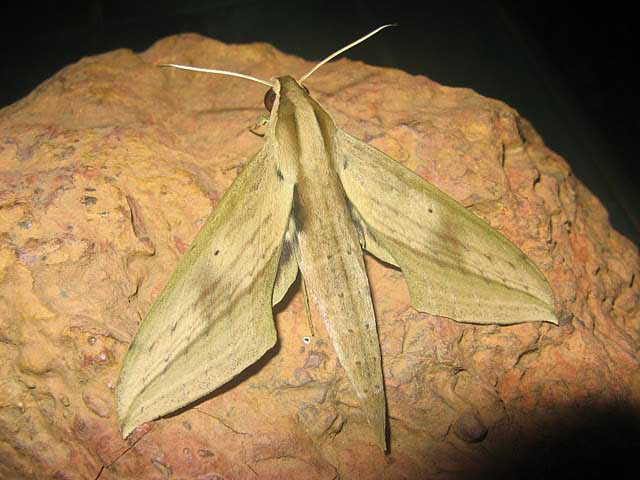
Xylophanes anubus anubus, Camp Caiman, near Kaw, French Guiana,
April 29, 2011, courtesy of Andres urbas.
This site has been created by
Bill Oehlke at oehlkew@islandtelecom.com
Comments, suggestions and/or additional information are welcomed by Bill.
TAXONOMY:
Family: Sphingidae, Latreille, 1802
Subfamily: Macroglossinae, Harris, 1839
Tribe: Macroglossini, Harris, 1839
Genus: Xylophanes Hubner [1819] ...........
Species: anubus anubus Cramer, 1777
|
DISTRIBUTION: Xylophanes anubus anubus moths
(approximate wingspan: males: 93-102 mm; females: 115mm)
fly in
Suriname (specimen type locality);
Mexico;
Belize: Corozol, Cayo, Toledo;
Guatemala: Izabal (JM);
Honduras: Atlantida, Yoro (35m-1450m);
Nicaragua;
Costa Rica and south to
Venezuela;
French Guiana: Kaw;
Peru: Yahuarmayo (1400 feet);
Brazil: Maranhao,
Bolivia: Santa Cruz: Guarayos,
Perseverancia; Ichilo, Buena Vista (750m);
La Paz: Sud Yungas, Chulumani, (2000m);
Paraguay: Concepcion,
Central, Cordillera, Alto Parana, (probably Caaguazu Caazapa and Itapua (WO??));
and
Argentina: Misiones; Corrientes.
Xylophanes anubus, Ocosingo in Mexico (Chiapas), courtesy of
Hans Riefenstahl. | 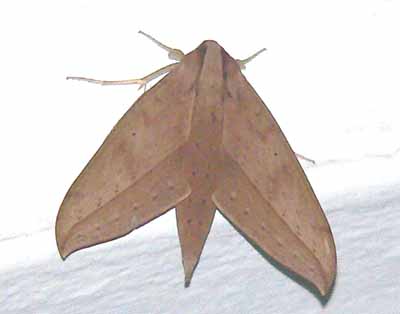 |
Chaerocampa nitidula Clemens, 1859, Mexico, is same as Xylophanes anubus anubus
Choerocampa laevis Grote & Robinson, 1867, Mexico, is same as Xylophanes anubus anubus
Chaerocampa miradonis Boisduval, [1875], Mexico, is same as Xylophanes anubus anubus
Chaerocampa alcides Boisduval, [1875], Mexico, is same as Xylophanes anubus anubus
ab. infernalis Gehlen, 1926, Brazil, is same as Xylophanes anubus anubus
I suspect this species also flies in Panama, Colombia,
Guyana and Brazil.
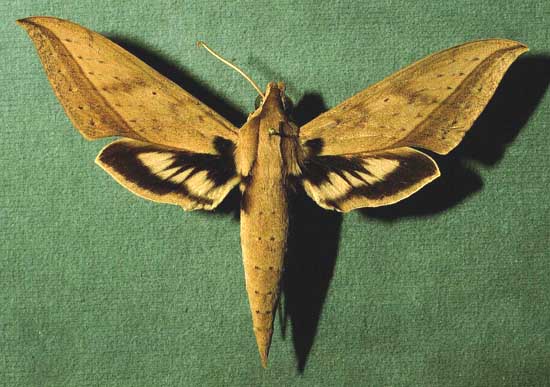
Xylophanes anubus anubus male courtesy of Dan Janzen.
"A very variable species in terms of size (forewing length 32-58 mm) and degree of development of the oblique lines of the forewing upperside; fresh specimens have a
greenish tint that quickly fades to buff-grey. Costal margin of forewing often rather strongly convex and apex recurved so that at rest, the moth has a “rounder”,
less triangular appearance (similar to Elibia dolichus in outline) that once recognized is characteristic of the species.
Abdomen with three dorsal lines; median line usually the most distinct but may be absent, lateral lines sometimes reduced to rows of dots.
Forewing upperside with or without a dark cloud distal to discal cell; seven oblique lines present of which the third is the heaviest; the lines posteriorly may be more, or
less, oblique; the three proximal lines often vestigial or indicated by vein dots; the three distal lines weak or absent, apart from the most distal, which is
minimally indicated by strong vein dots.
Black area variable in extent so that the pale median band is often much reduced; pale spots on M1 to M3 usually confluent but occasionally are separate." CATE
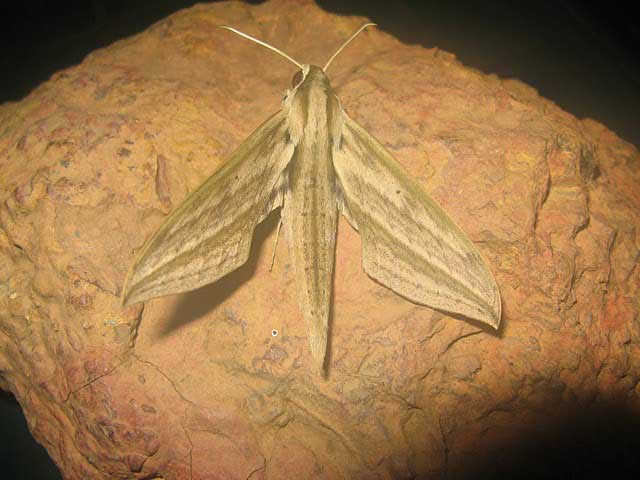
Xylophanes anubus anubus, Camp Caiman, near Kaw, French Guiana,
March 31, 2011, courtesy of Andres urbas.
FLIGHT TIMES:
Xylophanes anubus anubus adults
have been taken every month of the year (except March) in
Costa Rica. Andres Urbas reports March 31, 2011, and April 29, 2011, flights near Kaw, French Guiana.
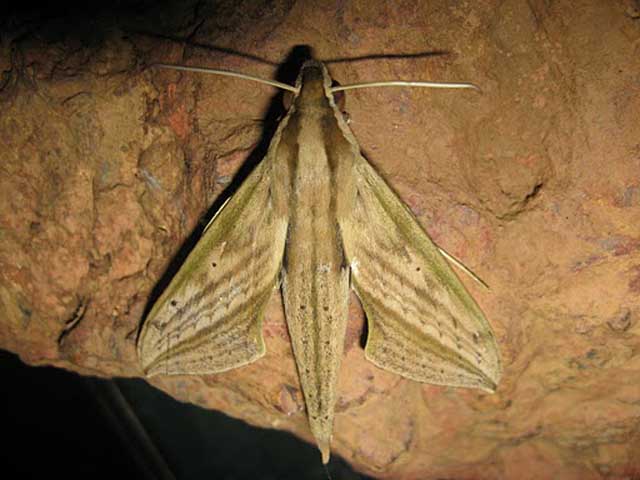
Xylophanes anubus anubus, Camp Caiman, near Kaw, French Guiana,
April 29, 2011, courtesy of Andres urbas.
ECLOSION:
Moths emerge from pupae formed in leaf litter.
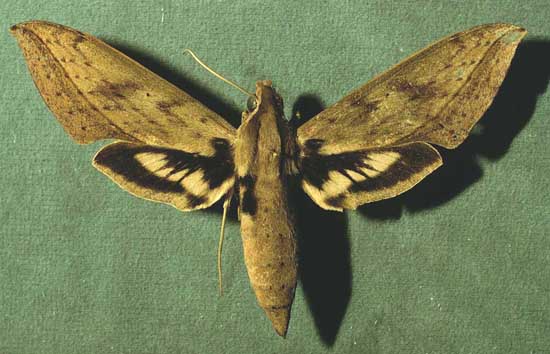
Xylophanes anubus anubus female courtesy of Dan Janzen.
SCENTING AND MATING:Females call in the males with a pheromone released from a gland at the tip of the
abdomen. Males come in to lights very readily, but females are seldom taken in that way.
EGGS, LARVAE, PUPAE:
Larvae feed on Psychotria panamensis, Psychotria chiapensis, Psychotria psychotriifolia and Psychotria nervosa
of the Rubiaceae family and on
Garroboof the Araceae family.
Most feeding takes place after dusk and larvae
often hide in leaf rolls during the day.
The first and second instars of this species are green,
changing to mottled brown at the third instar. When they are not feeding, early instar caterpillars hide in the terminal leaflets of the host
plant while later instars (3rd-5th) hide at the base of the plant or under a branch.
Larvae can be collected by checking the bases of damaged plants.
Caterpillars often eat half or part of a leaf, then move to a different leaf to feed. | 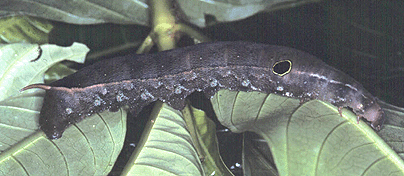 |
Some larvae are almost black.

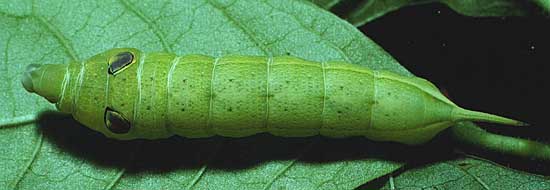
Moths emerge approximately fifteen to thirty days after larvae pupate.
Larvae are subject to parasitization from Thyreodon laticinctus of the Ichneumonidae family and Belvosia sp. of the Tachinidae family.
The pronunciation of scientific names is
troublesome for many. The "suggestion" at the top of the page is
merely a suggestion. It is based on commonly
accepted English pronunciation of Greek names and/or some
fairly well accepted "rules" for latinized scientific names.
The suggested pronunciations, on this page and on other pages,
are primarily put forward to assist those who hear with internal
ears as they read.
There are many collectors from different countries whose
intonations and accents would be different.
Jean Marie Cadiou writes, "When I say "Xylophanes" in English I
pronounce it something like "Zailophanees", with the emphasis on the
"o". The French pronounce it differently, something like
"Kzeelophaness" with no emphasis, and the Germans yet in a
different way..."
In Greek myth, Phanes is the golden winged Primordial Being who
was hatched from the shining Cosmic Egg that was the source of the
universe. He personifies light emerging from chaos.
"Xylo" is the Greek word for wood.
The specimen type for the genus
Xylophanes is Xylophanes anubus. Perhaps ? when Hubner
examined this species, the yellow-orange and brown tones of the
forewings suggested wings of wood.
The species name "anubus" probably comes from
the name assigned to the jackal-headed Egyptian god of the dead, Anubis or Anubus.
Use your browser "Back" button to return to the previous page.
Goto Main Sphingidae Index
Goto Macroglossini Tribe
Goto Central American Indices
Goto Carribean Islands
Goto South American Indices
Goto U.S.A. tables








